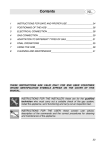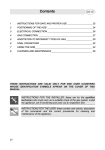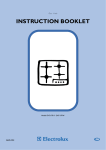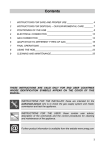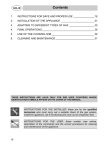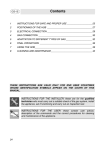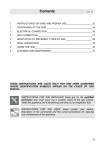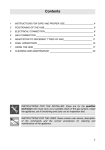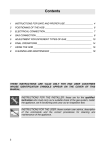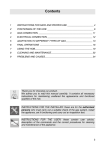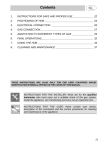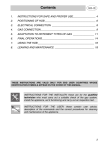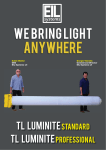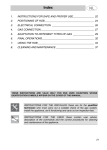Download Smeg SE63TF3 hob
Transcript
Contents 1 INSTRUCTIONS FOR SAFETY AND USE __________________________ 28 2 SAFETY PRECAUTIONS _______________________________________ 30 3 ENVIRONMENTAL RESPONSIBILITY _____________________________ 32 4 POSITIONING OF THE HOB ____________________________________ 33 5 ELECTRICAL CONNECTION ____________________________________ 35 6 GAS CONNECTION ___________________________________________ 36 7 ADAPTATION TO DIFFERENT TYPES OF GAS _____________________ 38 8 FINAL OPERATIONS __________________________________________ 42 9 USING THE HOB______________________________________________ 45 10 CLEANING AND MAINTENANCE_________________________________ 48 THESE INSTRUCTIONS ARE VALID ONLY FOR END USER COUNTRIES WHOSE IDENTIFICATION SYMBOLS APPEAR ON THE COVER OF THIS MANUAL. INSTRUCTIONS FOR THE INSTALLER: these are for the qualified technician who must carry out a suitable check of the gas system, install the appliance, set it functioning and carry out an inspection test. INSTRUCTIONS FOR THE USER: these contain user advice, description of the commands and the correct procedures for cleaning and maintenance of the appliance. 27 General instructions 1 INSTRUCTIONS FOR SAFETY AND USE THIS MANUAL IS AN INTEGRAL PART OF THE APPLIANCE. IT MUST BE KEPT IN ITS ENTIRETY AND IN AN ACCESSIBLE PLACE FOR THE WHOLE WORKING LIFE OF THE HOB. WE ADVISE YOU TO READ THIS MANUAL AND ALL THE INFORMATION IT CONTAINS CAREFULLY BEFORE USING THE HOB. ALSO KEEP THE SERIES OF NOZZLES PROVIDED. INSTALLATION MUST BE CARRIED OUT BY COMPETENT PERSONS IN ACCORDANCE WITH THE REGULATIONS IN FORCE. THIS APPLIANCE IS INTENDED FOR HOUSEHOLD USE AND COMPLIES WITH THE EEC DIRECTIVES CURRENTLY IN FORCE. THE APPLIANCE HAS BEEN BUILT TO CARRY OUT THE FOLLOWING FUNCTIONS: COOKING AND HEATING OF FOODS; IT IS CONSIDERED UNSUITABLE FOR ANY OTHER USE. THE MANUFACTURER CANNOT BE HELD LIABLE FOR USE OTHER THAN AS INDICATED. IF THE APPLIANCE IS INSTALLED ON BOATS OR IN CARAVANS, DO NOT USE IT AS A ROOM HEATER. DO NOT USE THIS APPLIANCE FOR HEATING ROOMS. THIS APPLIANCE IS MARKED ACCORDING TO EUROPEAN DIRECTIVE 2002/96/EC ON WASTE ELECTRICAL AND ELECTRONIC EQUIPMENT (WEEE). THIS DIRECTIVE DEFINES THE STANDARDS FOR THE COLLECTION AND RECYCLING OF WASTE ELECTRICAL AND ELECTRONIC EQUIPMENT APPLICABLE THROUGHOUT THE EUROPEAN UNION. THE IDENTIFICATION PLATE WITH THE TECHNICAL DATA, SERIAL NUMBER AND BRAND NAME HAS BEEN VISIBLY AFFIXED TO THE APPLIANCE. DO NOT REMOVE THIS PLATE FOR ANY REASON. BEFORE OPERATING THE APPLIANCE ALL PROTECTIVE COVERS MUST BE REMOVED. 28 General instructions SUITABLE HEAT-PROOF GLOVES SHOULD BE WORN FOR ALL OPERATIONS. DO NOT USE STEEL SPONGES OR SHARP SCRAPERS AS THEY WILL DAMAGE THE SURFACE. USE NORMAL NON-ABRASIVE PRODUCTS AND A WOODEN OR PLASTIC TOOL IF NECESSARY. RINSE THOROUGHLY AND DRY USING A SOFT CLOTH OR A MICROFIBRE CLOTH. DO NOT LEAVE THE APPLIANCE UNATTENDED DURING COOKING PROCESSES WHERE FATS OR OILS COULD BE RELEASED. FATS AND OILS MAY CATCH FIRE. ALWAYS CHECK THAT THE CONTROL KNOBS ARE IN THE POSITION WHEN YOU FINISH USING THE HOB. O (OFF) NEVER PLACE PANS WITH BOTTOMS WHICH ARE NOT PERFECTLY FLAT AND SMOOTH ON THE COOKING HOB PAN STANDS. NEVER USE PANS WHICH PROJECT BEYOND THE OUTSIDE EDGE OF THE HOB. 29 General instructions 2 SAFETY PRECAUTIONS REFER TO THE INSTALLATION INSTRUCTIONS FOR THE SAFETY REGULATIONS FOR ELECTRIC OR GAS APPLIANCES AND VENTILATION FUNCTIONS. IN YOUR INTERESTS AND FOR YOUR SAFETY THE LAW REQUIRES THAT THE INSTALLATION AND SERVICING OF ALL ELECTRICAL APPLIANCES IS CARRIED OUT BY QUALIFIED PERSONNEL IN ACCORDANCE WITH THE REGULATIONS IN FORCE. OUR APPROVED INSTALLERS GUARANTEE A SATISFACTORY JOB. GAS OR ELECTRICAL APPLIANCES MUST ALWAYS BE DISCONNECTED BY SUITABLY SKILLED PEOPLE. BEFORE CONNECTING THE APPLIANCE TO THE POWER GRID, CHECK THE DATA ON THE PLATE AGAINST THE DATA FOR THE GRID ITSELF. THE IDENTIFICATION PLATE CONTAINING THE TECHNICAL DATA, SERIAL NUMBER AND BRAND NAME IS IN A VISIBLE POSITION UNDER THE CASING. DO NOT REMOVE THIS PLATE ON THE CASING FOR ANY REASON. BEFORE CARRYING OUT INSTALLATION/MAINTENANCE WORK, MAKE SURE THAT THE APPLIANCE IS NOT CONNECTED TO THE POWER GRID. THE PLUG TO BE CONNECTED TO THE POWER SUPPLY CABLE AND ITS SOCKET MUST BE OF THE SAME TYPE AND CONFORM TO THE REGULATIONS IN FORCE. THE SOCKET MUST BE ACCESSIBLE AFTER THE APPLIANCE HAS BEEN BUILT IN. NEVER DISCONNECT THE PLUG BY PULLING ON THE CABLE. IF THE POWER SUPPLY CABLE IS DAMAGED, CONTACT THE TECHNICAL SUPPORT SERVICE IMMEDIATELY AND THEY WILL REPLACE IT. IT IS OBLIGATORY FOR ALL ELECTRICAL EQUIPMENT TO BE EARTHED ACCORDING TO THE METHODS LAID DOWN BY SAFETY REGULATIONS. 30 General instructions IMMEDIATELY AFTER INSTALLATION, CARRY OUT A QUICK TEST ON THE APPLIANCE FOLLOWING THE INSTRUCTIONS PROVIDED LATER IN THIS MANUAL. SHOULD THE APPLIANCE NOT FUNCTION, DISCONNECT IT FROM THE POWER SUPPLY AND CALL THE NEAREST TECHNICAL ASSISTANCE CENTRE. NEVER ATTEMPT TO REPAIR THE APPLIANCE. DURING USE THE APPLIANCE BECOMES VERY HOT. BE CAREFUL NOT TO TOUCH THE HEATING ELEMENTS. THIS APPLIANCE MUST NOT BE USED BY PEOPLE (INCLUDING CHILDREN) OF REDUCED PHYSICAL AND MENTAL CAPACITY, OR LACKING IN EXPERIENCE IN THE USE OF ELECTRICAL APPLIANCES, UNLESS THEY ARE SUPERVISED OR INSTRUCTED BY ADULTS WHO ARE RESPONSIBLE FOR THEIR SAFETY. DO NOT LET CHILDREN GO NEAR THE APPLIANCE WHEN IT IS IN OPERATION OR PLAY WITH IT AT ANY TIME. DO NO OT INSERT POINTED METAL OBJECTS (CUTLERY OR UTENSILS) INTO THE SLITS IN THE APPLIANCE. DO NOT USE STEAM JETS FOR CLEANING THE APPLIANCE. THE STEAM COULD REACH THE ELECTRONICS, DAMAGING THEM AND CAUSING SHORT-CIRCUITS. DO NOT MODIFY THIS APPLIANCE. DO NOT SPRAY ANY SPRAY PRODUCTS NEAR THE ELECTRICAL APPLIANCE WHILE IT IS IN OPERATION. DO NOT USE SPRAY PRODUCTS WHILE THE PRODUCT IS STILL HOT. The manufacturer cannot be held liable for damage to persons or things caused by failure to observe the above instructions, by interference with any part of the appliance or by the use of non-original spare parts. 31 Instructions for disposal 3 ENVIRONMENTAL RESPONSIBILITY Our product's packing is made of non-polluting materials, which are therefore compatible with the environment and recyclable. Please help by disposing of the packaging correctly. You can obtain the addresses of collection, recycling and disposal centres from your retailer or from the competent local organisations. Do not discard the packaging or any part of it, or leave it unattended. It can constitute a suffocation hazard for children, especially the plastic bags. Your old appliance also needs to be disposed of correctly. Important: hand over your appliance to the local agency authorised for the collection of electrical appliances no longer in use. Correct disposal enables intelligent recovery of valuable materials. Before disposing of your appliance it is important to remove doors and leave shelves in the same position as for use, to ensure that children cannot accidentally become trapped inside during play. It is also necessary to cut the connecting cable to the power supply network, removing it along with the plug. 3.1 Your environmental responsibility Our product's packing is made of non-polluting materials, which are therefore compatible with the environment and recyclable. Please help by disposing of the packaging correctly. You can obtain the addresses of collection, recycling and disposal centres from your retailer or from the competent local organisations. Do not discard the packaging or any part of it, or leave it unattended. It can constitute a suffocation hazard for children, especially the plastic bags. Your old appliance also needs to be disposed of correctly. Important: hand over your appliance to the local agency authorised for the collection of electrical appliances no longer in use. Correct disposal enables intelligent recovery of valuable materials. Before disposing of your appliance it is important to remove doors and leave shelves in the same position as for use, to ensure that children cannot accidentally become trapped inside during play. It is also necessary to cut the connecting cable to the power supply network, removing it along with the plug. 32 Instructions for the installer 4 POSITIONING OF THE HOB The following operation requires building and/or carpentry work so must be carried out by a competent tradesman. Installation can be carried out on various materials such as masonry, metal, solid wood or plastic laminated wood as long as they are heat resistant (T 90°C). 4.1 Attachment to support structure Create an opening with the dimensions shown in the figure in the top surface of the counter, keeping a minimum distance of 50 mm from the rear border. This appliance is classified as “type Y” in relation to fire hazards and can therefore be mounted against walls higher than the work surface on condition that a certain distance “X” be kept between the appliance and the wall as shown in the figure so as to avoid damage from overheating. Make sure there is a minimum of 750 mm between the hot plate flames and any shelf that may be installed directly above them. Carefully position the insulating seal supplied on the outer perimeter of the hole made in the counter top as shown in figure 4 (the dimensions in the figure refer from the hole to the inside of the seal), trying to ensure that it sticks across the whole of its surface by applying light pressure with your hands. Fix the hob to the unit using the appropriate brackets B and spacer A as shown in figures 1, 2 and 3. Spacer A will help to keep the hob top at the right distance from the edge of the counter top to avoid future overheating during operation and must be used solely in the front left-hand corner of the appliance. Carefully trim the surplus away from edge C beyond the seal (Fig.5). 33 Instructions for the installer B B 20 ÷ 40 A+B A B B B B Fig.1 Fig.2 A B Fig.3 Fig.4 34 Fig.5 Instructions for the installer 5 ELECTRICAL CONNECTION Make sure that the voltage and capacity of the power line conform to the data shown on the plate located under the casing. Do not remove this plate for any reason. The plug on the end of the supply cable and the wall socket must be the same type and conform to the current electrical system regulations. Check that the power line is adequately grounded. On the power line, install an omnipolar cut-off device with contact cutoff distance greater than or equal to 3 mm, located in an easily accessible position near the unit. Do not use reducers, adapters or shunts. If the power cable is replaced, the wire section on the new cable must not be less than 1 mm 2 (3 x 1 cable), keeping in mind that the end to be connected to the hob must have the ground wire (yellow-green) longer by at least 20 mm. Use only H05V2V2-F cable or similar which has a maximum temperature of 90°C. Any replacement needed should be carried out by a specialised technician who should make the mains connections according to the following diagram. L = brown N = blue = yellow-green The manufacturer will not be liable for any damage to persons or property caused by non-observance of the above instructions or deriving from the tampering of even a single part of the hob. 35 Instructions for the installer 6 GAS CONNECTION Connection to the gas mains may be made with a rigid copper pipe or with a flexible pipe and conforming to the provisions defined by standard regulations in force. To facilitate connection, fitting A on the rear of the appliance may be adjusted laterally. For this purpose, loosen hexagon nut B, turn fitting A to the desired position, and retighten hexagon nut B (tightness is ensured by a biconical brass ring). Use a soapy solution to check for proper tightness. Never use a free flame. The hob has been inspected for G20 (2H) natural gas at a pressure of 20 mbar. For use with other types of gases, see Section “7. ADAPTATION TO DIFFERENT TYPES OF GAS”. The gas intake fitting is ½” gas external threaded (ISO 2281). Connection with rigid copper pipe: the connection to the gas mains must not provoke stress of any kind on the hob. Connection may be made by using biconical adapter D with insertion of gasket C (supplied). Connection with flexible pipe: use only flexible pipes conforming to standard regulations in force, inserting gasket C (supplied) between fitting A and flexible pipe E. The flexible pipe has to be installed so that pipe length does not exceed 1.5 meters of maximum extension. Make sure that the pipes do not touch any moving parts or become damaged. 36 Instructions for the installer 6.1 Connection to LPG Use a pressure regulator and make the connection to the tank according to the provisions of standards regulations in force. Make sure that feed pressure conforms to the levels shown in the table in paragraph “ 0 Regulation for LPG”. 6.2 Ventilation of rooms The hob may be installed only in rooms with permanent ventilation, as required by standards regulations in force. The room in which the hob is installed must have sufficient air flow to satisfy the requirements of normal gas combustion and of necessary air exchange in the room. The air intakes, protected by screens, must be appropriately sized (regulations in force) and placed so as not to be blocked in any way. The room where the oven is installed should be suitably ventilated to avoid overheating or excess humidity produced by cooking, and in the case of lengthy use a window should be opened or the speed of any ventilators should be increased. 6.3 Discharge of combustion products Discharge of combustion products may be guaranteed by means of hoods connected to a natural draught flue with certain efficiency, or by means of forced aspiration. An efficient aspiration system requires careful planning by a specialist capable of installing it, respecting the positions and distances prescribed by standards. After installation, the installer must issue a certificate of conformity. 37 Instructions for the installer 7 ADAPTATION TO DIFFERENT TYPES OF GAS Before performing any cleaning or maintenance work, disconnect the appliance from the electrical socket. The hob has been inspected for G20 (2H) natural gas at a pressure of 20 mbar. For functioning with other types of gas the nozzles must be replaced and the primary air adjusted. To replace the nozzles and regulate the burners, you have to remove the top as described in the following paragraph. 7.1 1. 2. 3. 4. 7.2 1. Removing the separable control panel (models with separable control panel) Remove the knobs and the knob guard tube “A” by pulling them up; Use a crosshead screwdriver to remove the screws and the two cylindrical supports “B”; Raise the left-hand side of the control panel slightly and shift it to the right to remove it completely; In models with electric hotplate, the body of the pilot light has to be removed to free the control panel; Removing the hob (models with integrated control panel) Remove the knobs, the griddles, the burner caps, the flame caps and the two rear plugs; 2. Remove the screws “A” which fix the burner supports; Raise the hob, sliding it off the ignition plugs and/or the thermocouples and the gas tap rods; 38 Instructions for the installer 7.3 Regulation for LPG Check that the connection has been made as described in the “Gas connection” section. Undo the screw “D” and push the air regulator “C” fully down. Use a spanner to remove the nozzles “B” and fit those of suitable type following the instructions given in the tables for bottled gas G30/G31 – 28/37 mbar. The nozzle must not be tightened to a torque of over 3 Nm. Regulate the air flow by moving the Venturi pipe “C”, until the gap “A” is as shown in the table in point “7.5 Regulation of primary air” and fix it with the screw “D”. After making the adjustments, restore the seals with sealing wax or an equivalent material. Burner Rated heating capacity LPG – G30/G31 28/37 mbar Nozzle Diameter 1/100 mm Reduced flowrate (W) Flowrate g/h G30 Flowrate g/h G31 Auxiliary 1.05 48 450 76 75 Semi-rapid 1.8 62 500 131 129 Rapid 2.55 76 750 185 182 Rapid large 3.1 85 850 225 222 Fish pan 2.9 82 950 211 207 Ultra rapid 4.0 95 1600 291 286 39 Instructions for the installer 7.4 Regulation for natural gas The hob has been inspected for G20 (2H) natural gas at a pressure of 20 mbar. To allow the unit to work with this type of gas, perform the same operations described in paragraph “ 0 Regulation for LPG”, but choose the nozzles and regulate the primary air for natural gas, as shown in the following table and in paragraph “ 7.5 Regulation of primary air”. After the regulations have been carried out, restore the seals with sealing wax or equivalent material. Burner Auxiliary Rated heating capacity 1.05 Natural gas – G20 20 mbar Nozzle diameter 1/100 mm Reduced flowrate (W) 73 400 Semirapid 1.8 93 450 Rapid 2.55 115 750 Rapid large 3.1 128 750 Fish pan 2.9 123 950 Ultra rapid 4.0 142 1400 40 Instructions for the installer 7.5 Regulation of primary air Referred to distance “A” in mm. 60 cm hobs with separable control panel. G20 Burner 20 mbar G30/G31 28/37 mbar Auxiliary (1) 3.0 4.0 Semirapid r (2) 1.0 2.0 Semirapid l (3) 1.0 2.0 Rapid large (4) 1.0 3.5 Ultrarapid (5) 1.0 5.0 90 cm hobs with separable control panel. G20 Burner 20 mbar G30/G31 28/37 mbar Auxiliary (1) 2.5 3.0 Semirapid (2) 1.0 2.0 Rapid (3) 1.5 1.5 Fish burner (4) 0.5 8.0 Ultrarapid (5) 1.5 60 cm hob with built-in control panel. G20 Burner 20 mbar 3.0 G30/G31 28/37 mbar Auxiliary (1) 3.0 4.0 Semirapid r (2) 1.0 2.0 Semirapid l (3) 1.0 2.0 Rapid medio (4) 1.5 3.5 Ultrarapid (5) 1.0 4.0 To identify the burners on your hob, refer to the drawings in point “8.3/8.4 Arrangement of burners on hob “ 41 Instructions for the installer 8 FINAL OPERATIONS Having carried out the above adjustments, reassemble the appliance following, backwards, the instructions in paragraph “7.1 Removing the separable control panel / 7.2 Removing the hob”. 8.1 Regulation of minimum for natural gas Reposition the components on the burner and slide the knobs onto the cock stems. Light the burner and set it on the minimum position. Take the knob off again and turn the regulating screw on the side of the cock stem until a steady minimum flame is achieved. Refit the knob and verify the burner flame is stable (turning the knob rapidly from the maximum to the minimum position the flame must not go out). 8.2 Regulation of minimum for LPG To regulate the minimum for LPG, completely tighten (clockwise) the screw inside or next to the gas tap pin (depending on the model). The diameters of the by-passes for each burner are given in table “ 0 Regulation for LPG”. After having regulated the device with gas other than the one tested, replace the label located on the guard with the one that corresponds to the new gas. The label is inside the bag that contains the nozzles provided. 42 Instructions for the installer 8.3 Arrangement of the burners on the hob (Hob with separable control panel) 60 cm. hob BURNERS 1. 2. 3. 4. 5. Auxiliary Semirapid r Semirapid l Rapid large Ultrarapid 90 cm. hob BURNERS 1. 2. 3. 4. 5. Auxiliary Semirapid Rapid Fish burner Ultrarapid 43 Instructions for the installer 8.4 Arrangement of the burners on the hob (Hob with built-in control panel). 60 cm. hob BURNERS 1. 2. 3. 4. 5. 8.5 Auxiliary Semirapid r Semirapid l Rapid Ultrarapid Lubrication of gas taps With time it may happen that the gas taps get blocked and hard to turn. Clean them inside and re-grease them. This operation must be done by an authorised person. 44 Instructions for the user 9 USING THE HOB Before turning on the burners, make sure that the burner rings, caps and grids have been fitted correctly. In the ultrarapid burner, notch A must be aligned with pin B. Grid C provided is intended for use with woks (Chinese pans). Adapter D comes only with open grids models and is intended for use with small sized vessels. 9.1 Ignition of the burners The device is fit with electronic ignition. Simply press and simultaneously turn the knob counter-clockwise on the low point flame symbol, until the burner is ignited. In models with safety valve, the knob has to be turned to the ignition symbol before it is pressed, and after ignition the knob has to be kept pressed for about 2 seconds to keep the flame lit and to activate the safety device. The burner might go off when the knob is released. In this case repeat the aforesaid operation keeping the knob pressed for more than 2 seconds. Should the burners go off accidentally in the models with valves, a safety device will trip after approximately 20 seconds to block the gas outlet even if the cock is open. 9.2 Practical advice for using the burners For better burner performance and minimum gas consumption, flat bottomed, even pans must be used, with covers and proportional in size to the burners (see paragraph “9.3 Diameter of the pans”). To avoid overcooking or damage to the surface top 45 Instructions for the user while cooking, all pans or griddles must be positioned within the cooking hob perimeter and must be a minimum distance of 3-4 cm from the knobs. 9.3 Diameter of the pans Burners Ø min. and max. (en cm.) Auxiliary 12-14 Semirapid 16-20 Rapid medio 22-26 Rapid large 22-26 Ultrarapid 22-26 Fish burner 9.4 Special oval-shaped vessels Electric elements 9.4.1 Turning on electric elements Hobs may be fitted with an electric element of varying diameter. The electric element is controlled by a switch and is turned on by rotating the appropriate knob to the desired position. 9.4.2 Using the electric elements The settings shown in the table are merely indicative. 46 POSITION HEAT INTENSITY POSSIBLE COOKING 0 Off 1 Wreak To melt butter, chocolate, etc. To heat small amounts of liquid. 2 Soft To heat larger amounts of liquid. 3 Slow To defrost frozen food and prepare stews, cooking at or just below boiling point. 4 Medium To cook food which has to reach boiling point, to roast delicate meat Instructions for the user or fish. 5 Strong For roasts, steaks and large boiled joints. 6 Very strong To boil large amounts of water, to fry. WARNING When switching on the electric element for the first time, or if the electric element has not been used for a long time, to remove any humidity from the insulating material it should be dried out by placing the electric element on position 1 for 30 minutes. To use correctly remember to: • Switch the electric element only after having placed the pan on it. • Use flat and thick bottomed pans. • Never use pans which are smaller than the electric element. • Dry the bottom of the pan before placing it on the electric element. • When cooking with flammable oils and fats, never leave the appliance. • The electric elements will stay hot for a long time after use: do not touch them or place any objects on them. • If any dents appear in the electric element surface, switch it off immediately and contact the nearest authorised servicing centre. • Never place sheets of aluminium foil directly on the surface of the hotplate. 9.5 Using a griddle plate A few precautions are necessary if you wish to use a griddle plate: • leave a gap of at least 160 mm between the edge of the griddle plate and the side wall; • if one of the burners close to the wooden rear wall is of triple flame type, leave a gap of at least 160 mm between this wall and the edge of the griddle plate; • do not allow the burner flames to extend beyond the edge of the griddle plate; • operate the burners underneath the griddle plate for 10 minutes at maximum power, then turn them down to the minimum setting. Never use the griddle plate for more than 45 minutes. 47 Instructions for the user 10 CLEANING AND MAINTENANCE Never use a steam jet to clean the appliance. Before any intervention, disconnect the power supply of the device. 10.1 Cleaning Clean the cooking top regularly every time you use it, obviously after it has cooled. 10.1.1 Regular daily cleaning of the hob In order to clean and preserve the surface, always use specific products only, which do not contain abrasive substances or chlorinebased acid substances. How to use: pour the product on a damp cloth and wipe the surface, rinse thoroughly and dry with a soft cloth or deerskin. 10.1.2 Food stains or residues Do not use metallic sponges or sharp scrapers: they will damage the surface. Use normal non-abrasive products and remove spots or residuals with non-scratch sponges or, if need be, with wood or plastic utensils. Rinse thoroughly and dry with a soft cloth or deerskin. 48 Instructions for the user 10.2 Cleaning of cooking hob components CAUTION: do not wash these components in a dishwasher. In normal use of the hob, the stainless steel burner caps and panstands tend to be burnished by the high temperature. Clean these parts using very fine abrasive sponges or similar commercial products. Then use a specific paste polish to restore the steel’s shine. Your local authorised after-sales technician is able to supply professional products for appliance cleaning and care. Grids, caps, flame cap crowns and burners can be removed for ease of cleaning. Wash them in warm water using a non-abrasive detergent, taking care to remove all tough spots. Before remounting, allow the components to fully dry out. In fact, humidity residues inside the burner holes might impair burner operation. 10.2.1 Ignition plugs and safety devices For good functioning of the lighting ignition plugs and the safety devices, keep them very clean. Check frequently and clean with a damp cloth when necessary. 10.2.2 The electric element After use, to make sure that the surfaces are clean and long lasting, the electric element must be treated with specific cleaning products which are available on the market. This necessary operation prevents oxidisation (rust formation). 10.2.3 The cover Clean the glass or steel cover, where mounted, with warm water. Never use abrasive sponges or detergents. Never lower the cover when burners or electric elements are on or still hot. Attention: the glass lid may break if overheated. Make sure that all the burners are switched off and let them cool down before lovering the lid. 49























